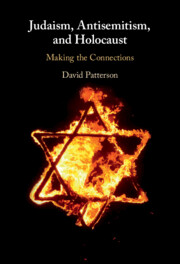Book contents
- Judaism, Antisemitism, and Holocaust
- Series page
- Judaism, Antisemitism, and Holocaust
- Copyright page
- Dedication
- Contents
- Preface
- Acknowledgments
- Introduction
- Part I Judaism
- Part II Antisemitism
- 5 The Why of Antisemitism
- 6 Word, Blood, Redemption
- 7 Anti-Zionism
- 8 Islamic Jihadism
- Part III Holocaust
- Bibliography
- Index
6 - Word, Blood, Redemption
The Essence of Antisemitism
from Part II - Antisemitism
Published online by Cambridge University Press: 24 March 2022
- Judaism, Antisemitism, and Holocaust
- Series page
- Judaism, Antisemitism, and Holocaust
- Copyright page
- Dedication
- Contents
- Preface
- Acknowledgments
- Introduction
- Part I Judaism
- Part II Antisemitism
- 5 The Why of Antisemitism
- 6 Word, Blood, Redemption
- 7 Anti-Zionism
- 8 Islamic Jihadism
- Part III Holocaust
- Bibliography
- Index
Summary
Here I argue that, inasmuch as antisemitism has a theological or ideological dimension, it manifests itself in three fundamental ways: the appropriation of the Word, the accusation and spilling of blood, and the determination of redemption. Always originating with highly sophisticated thinkers, antisemitism requires the appropriation or removal of the Holy Word in order to have the final word on the value of the human being and the higher relation that defines our humanity. In religious traditions this shows up as an appropriation of sacred texts; in the secular world we see it in texts like The Protocols of the Elders of Zion. Similarly, the antisemite demands purity, a demand manifest in blood libel, blood purification, and bloodletting: For the antisemite, sanctity means purity, and purity requires the elimination of the contagion, which is the Jew and the Judaism, and the contagion is in his or her blood. Finally, the antisemite must be the guardian of the gate to redemption, whether it lies in the salvation of the soul or in a utopian totalitarianism.
- Type
- Chapter
- Information
- Judaism, Antisemitism, and HolocaustMaking the Connections, pp. 120 - 142Publisher: Cambridge University PressPrint publication year: 2022

